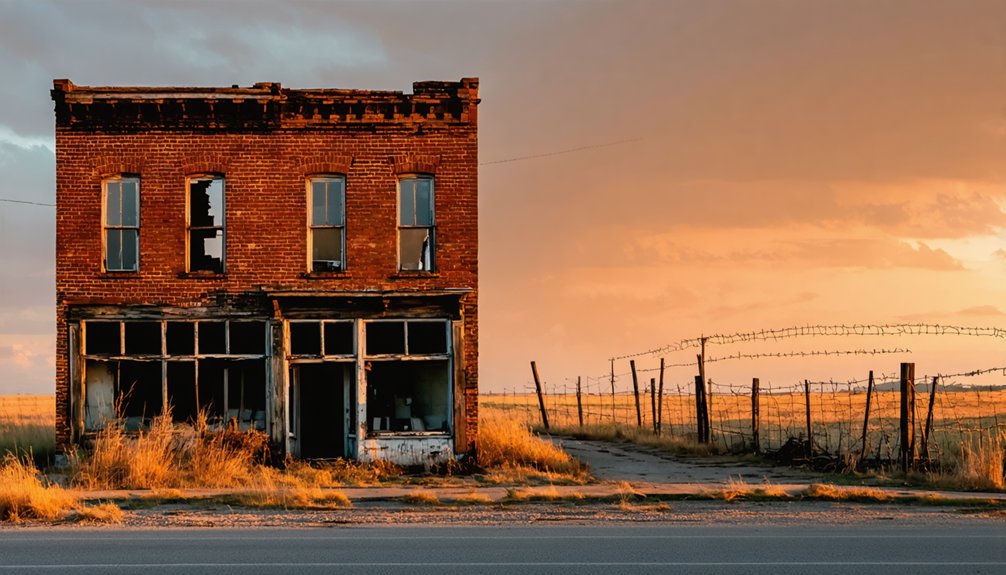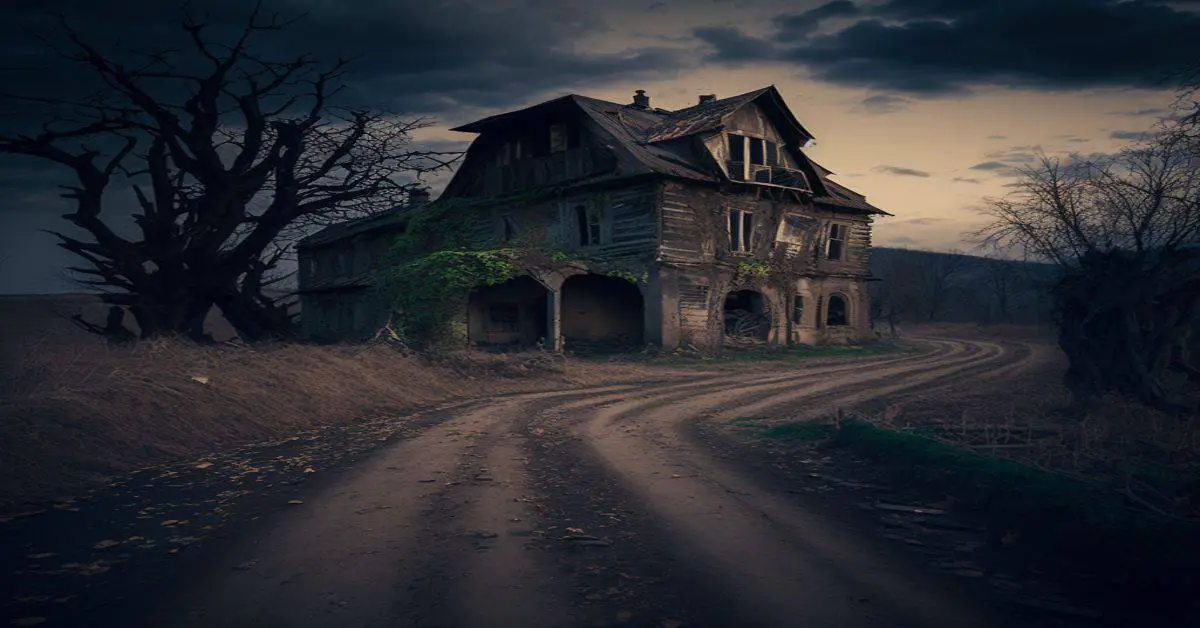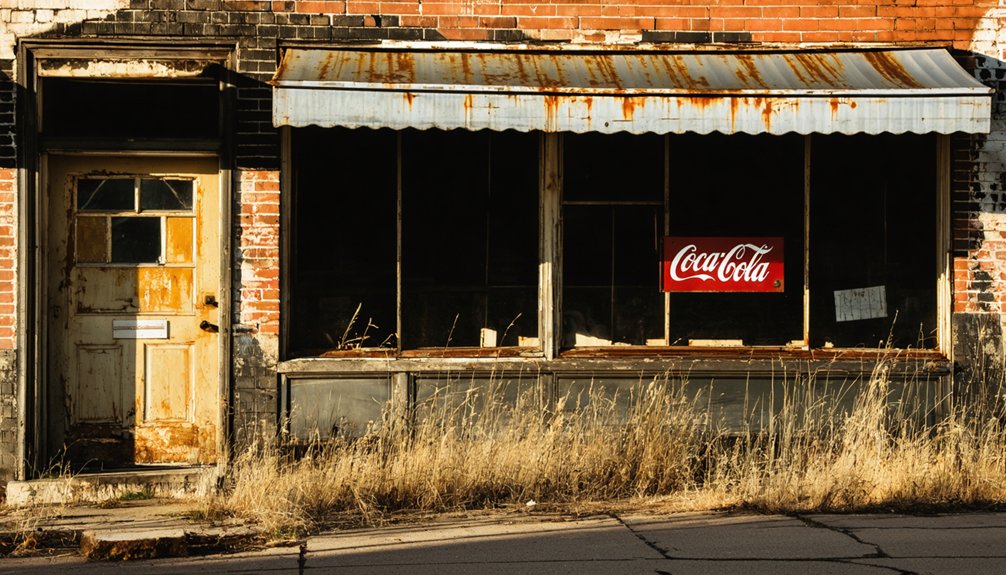You’ll find Reader (formerly Reeders) in Western Mound Township, Macoupin County, Illinois, at 581 feet elevation. This agricultural ghost town emerged during Illinois’s rural development in the 1800s, thriving on grain production and livestock trade. Local marketplaces, taverns, and blacksmith shops once served farmers before economic shifts led to its decline. Today, abandoned structures and weathered walls scattered among cornfields hold untold stories of this vanished rural community.
Key Takeaways
- Reader (formerly Reeders) is a ghost town in Western Mound Township, Macoupin County, Illinois, located at 581 feet above sea level.
- The settlement emerged during Illinois’s rural development period in the 1800s, primarily focused on logging and agricultural activities.
- Local economy thrived on agricultural trade, supported by livestock sales, grain production, and essential businesses like blacksmith shops.
- The town transitioned to abandonment in the late 19th century due to urban migration and shifting economic priorities.
- Few physical traces remain today, with abandoned structures scattered throughout farmland and limited historical documentation of its existence.
Historical Location and Rural Setting
Reader, formerly known as Reeders, sits at 581 feet above sea level in Western Mound Township, Macoupin County, Illinois.
You’ll find this ghost town at coordinates 39°18′20″N and 90°2′27″W, surrounded by the vast agricultural landscapes that define western Illinois’s rural character.
While its historical significance as an unincorporated settlement speaks to the region’s agricultural roots, today you’ll see mostly farmland dedicated to corn and soybeans.
The community’s structure reflects its remote nature, with no major highways nearby and access limited to local county roads.
You’re looking at classic Midwest terrain here – flat to gently rolling fields that stretch across the horizon.
For visitors seeking information about Reader, consulting a disambiguation page source can help distinguish this location from other places sharing similar names.
As part of the Metro-East area, Reader maintains its distinctly rural setting, far from the bustle of Illinois’s larger urban centers like Springfield.
Origins and Early Settlement
While historical records about Reeders’ founding remain scarce, what’s known suggests the settlement emerged during Illinois’s rural development period in the 1800s.
Like many frontier communities of that era, you’ll find that settlement patterns typically followed the paths of water sources and transportation routes, though Reeders’ exact relationship to these features isn’t documented.
The area’s early industries likely centered on logging and agriculture, following the common pattern of southern Illinois settlements. Early settlers benefited from cleared paths for travel, making the land more accessible than in previous decades.
Similar to how Brownsville served as a commerce hub, Reeders may have played a role in regional trade and government activities.
You won’t find Reeders mentioned prominently in ghost town registers, which points to its modest scale and limited historical footprint.
The settlement probably developed organically as pioneers sought opportunities in the region’s fertile lands, though specific details about its founding families and initial development have been lost to time.
Agricultural Roots and Local Economy
You’ll find that Reeders’ agricultural foundation emerged during Illinois’ rise to national grain production leadership in the 1860s, when the town served as an essential marketplace for local farmers.
The arrival of the Illinois & Michigan Canal and subsequent railroads transformed the region’s farming capabilities, enabling year-round shipment of grain to Chicago’s elevators and southern markets. Early settlers relied heavily on winter wheat cultivation, though severe crop failures in the late 1840s forced many to diversify their farming operations. The favorable growing seasons from 1849 to 1851 helped restore agricultural prosperity to the region.
As the local economy evolved, Reeders’ farmers adapted from wheat production to diverse grain and livestock operations, with notable success in shorthorn cattle breeding that attracted regional buyers and established the town’s reputation in McLean County’s agricultural network.
Farming as Local Foundation
As pioneers settled the rich glacial soils of Illinois in the mid-1800s, Reeders emerged as a farming community built on traditional agricultural practices.
You’d have found farmers preparing their fields each spring through manual plowing and harrowing, while implementing sustainable practices like plowing under crop residues to enrich the soil. Local farmers often worked together in threshing rings to share equipment and labor during harvest times.
The region’s agricultural foundation rested on crop diversity, with corn as the cornerstone crop alongside wheat, barley, and oats. After the post-Civil War drainage, farmers could utilize previously wet prairie soils for expanded crop production.
You would’ve seen mixed farming operations where livestock complemented crop production, creating a self-sustaining cycle – cattle and hogs provided manure for fields, while horses powered the farm work.
This diversified approach proved essential as Reeders’ farmers adapted to technological changes, from John Deere’s revolutionary steel plow to the gradual mechanization that transformed local agriculture.
Marketplace for Rural Community
The bustling marketplace of Reeders served as the heartbeat of this Illinois farming settlement, connecting local producers with enthusiastic buyers throughout the mid-1800s.
You’d find a vibrant mix of taverns, storerooms, and blacksmith shops supporting the daily needs of pioneering farmers. The marketplace dynamics centered on both livestock and grain trade, with cattle sales particularly active due to the region’s abundant corn crops. The economic evolution of the area followed a pattern seen across the frontier, as the region transitioned from grain-raising operations to more diverse commerce.
Rural commerce thrived as farmers brought their harvests and livestock to trade, transforming their agricultural output into cash or bartered goods. Local cattle feeders focused on using twenty to thirty pounds of corn daily to maximize beef weight for market sales.
The town’s marketplace competed fiercely with neighboring settlements, its success tied to reliable ferry services and steam-powered sawmills that facilitated the movement of goods. These amenities proved essential in attracting settlers and merchants, ultimately shaping Reeders’ economic fortunes.
Life in a Rural Illinois Hamlet
Life in rural Illinois hamlets during the early settlement period presented numerous challenges for pioneer families who ventured onto the prairie landscape.
You’d find yourself battling scarce timber resources, poor soil conditions, and limited water access while building your homestead from split logs. The harsh climate, including the devastating Winter of the Deep Snow in 1830-1831, tested your survival skills, while diseases like ague frequently struck your family. Residents had to dig wells 20 to 40 feet deep just to access drinking water.
Your social networks emerged through local institutions like churches, schools, and general stores, building community resilience despite initial isolation.
You’d rely heavily on self-sufficient farming practices, combining crops with livestock care. When the railroads finally arrived, they transformed your daily existence by connecting you to essential supplies, new markets, and expanded economic opportunities that weren’t previously available in these remote settlements.
Disappearance From the Map

Once a bustling rural settlement, Reeders gradually vanished from Illinois maps through a complex interplay of economic and social forces in the late 19th century.
You’ll find its disappearance followed a pattern common to many rural communities of that era. As urban migration drew residents away, the town’s essential economic anchors – its stores and community gathering places – shuttered one by one.
Economic shifts from agricultural dependence to industrial growth in larger cities left Reeders struggling to maintain its population. Without formal city limits or official incorporation, the town’s presence on maps became increasingly tenuous.
The physical traces of Reeders slowly faded as buildings were either dismantled or reclaimed by farmland, while natural overgrowth obscured what remained of the original townsite.
Modern-Day Landmarks and Remnants
Wandering through Reeders today, you’ll find scattered remnants of its former liveliness in abandoned commercial structures and deteriorating homes that dot the rural landscape.
The ghost town’s boundaries blur into the surrounding farmland, with no official markers to guide your exploration. You’ll navigate unpaved rural roads that follow original settlement patterns, revealing glimpses of life as it once was.
The abandoned buildings you’ll encounter tell silent stories through their weathered walls, though nature steadily reclaims these spaces.
While there aren’t any preserved landmarks like churches or schools remaining, the commercial ruins hint at bustling community life.
For the best rural exploration conditions, plan your visit during dry months when overgrowth is minimal and daylight illuminates the forgotten corners of this Midwestern ghost town.
Historical Records and Local Memory

You’ll find sparse historical records of Reeders preserved mainly through period maps and fragmentary local government documents, though significant gaps exist in both census data and oral histories from the town’s later years.
While neighboring communities like Braidwood maintained more complete historical documentation, Reeders’ story largely faded from local memory as its mining operations ceased and residents dispersed throughout Will County.
The disappearance of Reeders from official records mirrors the physical vanishing of the settlement itself, with only occasional mentions in county histories and geological surveys marking its brief existence as a coal mining community.
Map Preservation Through Time
Through meticulous documentation and preservation efforts, the geographical footprint of Reeders, Illinois has been maintained in various historical records and maps.
You’ll find that modern GIS technology has revolutionized how we track the map evolution of this ghost town, while traditional preservation techniques guarantee that original deed records and survey maps remain intact for future generations.
- Historical maps reveal the town’s original layout, showcasing the freedom pioneers sought when establishing Reeders.
- Property records trace how parcels changed hands over time, telling stories of hope and eventual decline.
- Digital archives now safeguard fragile paper maps from deterioration, preserving centuries of cartographic history.
- Local historical societies maintain collections of hand-drawn maps that capture detailed features long since vanished from the landscape.
Oral History Collection Gaps
While maps and property records tell part of Reeders’ story, significant gaps exist in the town’s oral history collection.
You’ll find no curated interviews, audio recordings, or published local histories that capture the community’s lived experiences. The absence of oral traditions is particularly striking – there’s no designated town historian or active historical society preserving local memories.
The fragmentation of community storytelling became more pronounced as commercial decline scattered the population.
Without city limit signs or public gathering spaces, opportunities for residents to share their stories have dwindled. What remains are mostly external observations from ghost town enthusiasts, focusing on physical structures rather than personal narratives.
The town’s isolation and small population have left its human story largely untold.
Census Data Missing Years
Despite extensive research efforts, Reeders faces significant gaps in its historical census records, with entire decades of population data missing from both state and federal archives.
These census discrepancies have left historians struggling to piece together the town’s demographic evolution and historical significance.
- You’ll find no official population counts for critical change periods when the town shifted from a bustling agricultural center to its eventual abandonment.
- State archivists haven’t located any local census records that might’ve filled these documentary gaps.
- You’re unable to track family movements and settlement patterns that could explain the town’s decline.
- The absence of reliable demographic data makes it impossible for you to determine exactly when Reeders reached its peak population or how quickly residents departed.
Frequently Asked Questions
What Was the Origin of the Name “Reeders”?
You’ll find Reeders’ history likely stems from an early settler or landowner named Reeder, though its name significance isn’t definitively documented in Illinois ghost town records or historical archives.
Were There Any Notable Residents Who Lived in Reeders?
You won’t find any famous inhabitants or historical figures documented as living in Reeders. Available records and historical surveys of Illinois ghost towns don’t mention any notable residents tied to this community.
Did Any Significant Civil War Events Occur Near Reeders?
You won’t find records of significant Civil War events or local skirmishes near this location, though Illinois played an essential role in supporting Union forces throughout the wider conflict.
What Type of Crops Were Primarily Grown by Reeders Farmers?
You’ll find that corn production dominated the farming landscape, with farmers using traditional farming techniques like crop rotation with oats and clover to maintain soil health and maximize yields.
Were There Any Native American Settlements in the Reeders Area?
You’ll find evidence of Native American settlements through historical artifacts in this area, where Kickapoo tribes controlled the land until their forced removal in the early 1800s under federal policies.
References
- https://www.heraldtimesonline.com/story/lifestyle/home-garden/2021/01/15/some-illinois-ghost-towns/43846097/
- https://michaelkleen.com/2021/11/23/coles-county-ghost-towns-hitesville-farmington-and-curtisville/
- https://www.youtube.com/watch?v=gM3ZIgtFzBk
- https://www.freakyfoottours.com/us/illinois/
- https://drloihjournal.blogspot.com/p/lost-towns-of-illinois-series.html
- http://genealogytrails.com/ill/christian/towns.html
- https://www.hmdb.org/m.asp?m=47311
- https://www.ghosttowns.com/states/il/reeders.html
- https://en.wikipedia.org/wiki/List_of_ghost_towns_in_Illinois
- https://en.wikipedia.org/wiki/Reeds_Crossing



